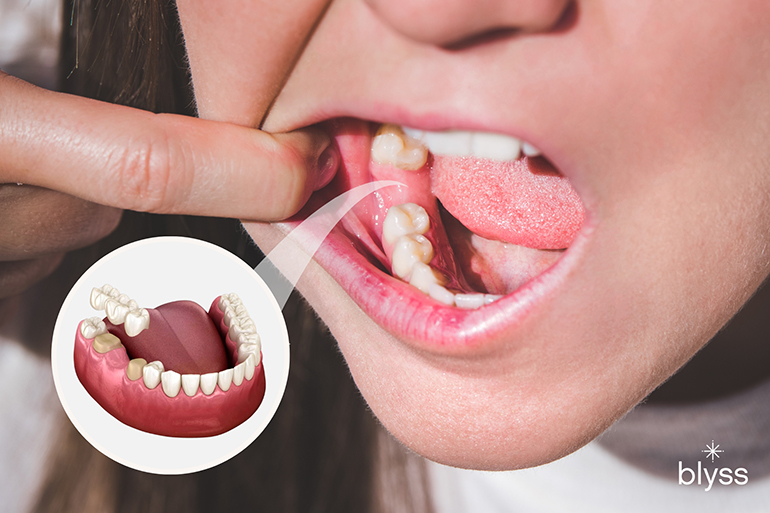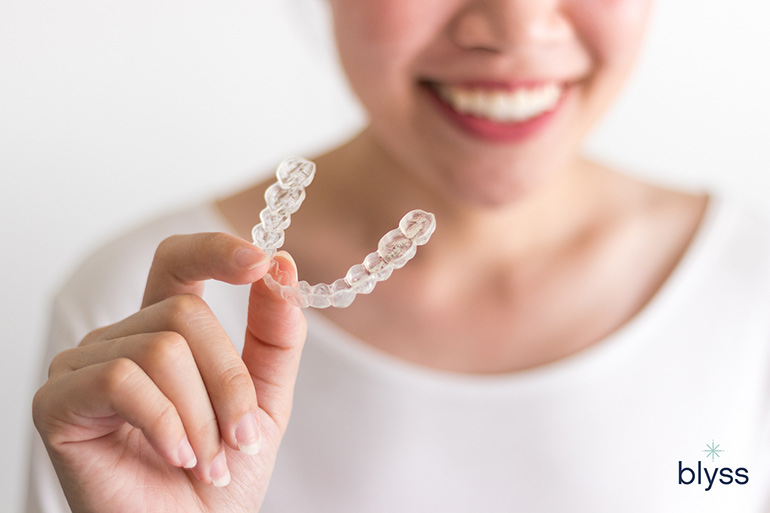Think you might need a dental bridge?
According to the American College of Prosthodontists, 120 million people in the U.S. are missing at least one tooth. This means that, like you, millions of Americans are also considering getting a dental bridge to replace their missing teeth.
As a dentist, I know missing a tooth can be quite uncomfortable. Not only does it make smiling, speaking, and chewing uncomfortable, but it can also affect your confidence and self-esteem.
Dental implants are usually the preferred option to restore your smile. However, not everyone is a good candidate for this procedure.
Dental bridges are often overlooked as an alternative to implants.
A bridge can provide an attractive and secure solution to replace one or more missing teeth. It restores your smile and normal oral functions such as chewing and speech. But, with so many different types of tooth replacements available, how do you know if a bridge is the right choice for you?
Here are six reasons why you may want to consider getting a dental bridge:
Reason 1: Restores Ability to Chew and Speak
One of the top reasons for getting a dental bridge is that it can restore your ability to chew and speak.
With fewer teeth in your mouth, the ones that remain have to bear more of the load during chewing. This can lead to uneven wear, discomfort, and further tooth loss over time.
A dental bridge can help restore your bite by replacing the missing teeth with false teeth that take on some of that workload.
Its design helps redistribute the load from chewing throughout your mouth and jaw, allowing you to eat comfortably again.
In addition to restoring your ability to chew, a dental bridge can also restore normal speech sounds.
Certain sounds require the precise movement of both our lips and tongue against our teeth while speaking. If one or more of these teeth are missing, it’s difficult for us to make those sounds correctly.
Replacing any missing teeth helps improve your ability to articulate words. This makes it easier for you to speak clearly and confidently.
So, say goodbye to garbled mumbles and say hello to clarity!
Reason 2: Restores Smile and Improves Appearance
Tooth loss can drastically alter your smile’s appearance. It can negatively affect how you look and feel about yourself.
Watch my video as I explain more about the effects of tooth loss:
A dental bridge is designed to fill any gaps in between your teeth and make your smile look like an unbroken row of teeth. This helps to maintain the shape of your face by preventing your face from sinking in after you lose some of your teeth.
With a dental bridge, you can get your smile back and restore your confidence, since you won’t have to feel embarrassed or self-conscious about any gaps in your teeth.
Reason 3: Improves Oral Health and Prevents Other Issues
If you have one or more missing teeth, the other adjacent teeth are likely to start shifting towards the gap. This shifting causes a misalignment of your remaining teeth.
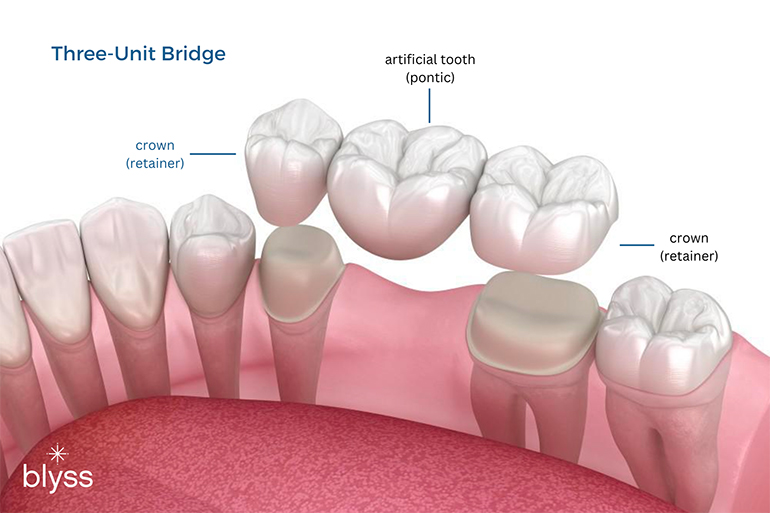
In a dental bridge, a false tooth (or pontic) is held in place by two crowns (or retainers) on either side of it. This design allows for the biting forces on all of your teeth to be equally distributed.
Getting a bridge helps keep your other teeth from shifting or moving.
Additionally, a dental bridge helps distribute the biting forces more evenly across all your teeth. This reduces the risk of wear and tear on your remaining teeth, which would otherwise suffer from excessive forces when chewing or biting down hard on food such as nuts or hard candy.
Reason 4: Fast Treatment Process with Minimal Discomfort
If you’ve been putting off going to the dentist for fear of discomfort or an overly difficult, drawn out process, then you’ll be happy to know that getting a dental bridge is fast with minimal discomfort.
Getting a dental bridge can be completed in as little as two visits: one for the preparation and one for the placement.
Here’s a step-by-step process of what happens during your first and second visits.
During the First Visit
- First, I will examine your mouth to check for any tooth decay or gum disease that needs to be treated.
- Next, I will numb you and then shape or prepare the teeth on either side of the gap where the retainers will be placed in preparation for the bridge.
- Once this is complete, I will take an impression of your mouth and make a mold of your teeth to send off to a lab, where they will custom-make your new bridge.
Before you walk out the door, I will put a temporary bridge to protect your prepared teeth while we wait for the permanent one. It generally takes about two weeks for it to be ready after your first visit.
Note that in some cases, a dental implant may be needed to anchor the bridge. This is usually the case if there are many missing teeth that need to be replaced.
During the Second Visit
- I will first remove the temporary bridge before fitting the permanent one.
- If necessary, the underlying teeth will be cleaned before applying bonding material to secure the appliance in place.
- Finally, I will secure the bridge to your abutment teeth using dental cement.
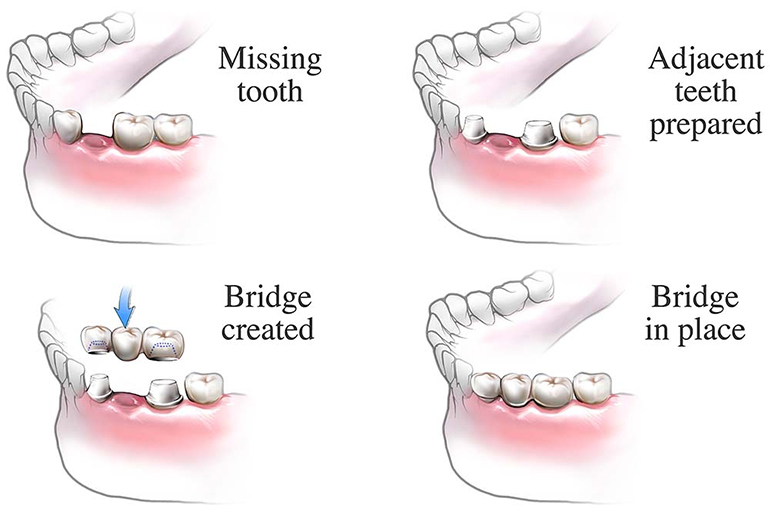
Getting a dental bridge involves shaping two healthy teeth and taking a mold to create your custom-made bridge.
In some cases, I may perform small modifications before cementing the bridge in place to ensure a comfortable fit.
While the bridge may feel strange at first, this sensation usually wears off quickly. You can enjoy the full functionality of a dental bridge immediately, with no waiting period.
The process of getting a dental bridge is also much less invasive than getting a dental implant.
Bridges do not require any type of surgery, unlike implants. This means less time in the chair and less time waiting for healing afterward. For this reason, it’s a great option for patients who cannot tolerate surgery for medical or other reasons.
Related Post: Dental Implant Healing Stages – What To Expect After Getting A Dental Implant
Reason 5: Durability and Longevity of Treatment Results
Dental bridges are incredibly durable. They generally last 10 to 15 years with proper care and maintenance, depending on the type, material, and patient care.
Dental bridges are highly resistant to shifting due to the support provided by the surrounding teeth. However, it is important to note that they are not indestructible.
Dental bridges often fail for the same reason you can have issues with your natural teeth.
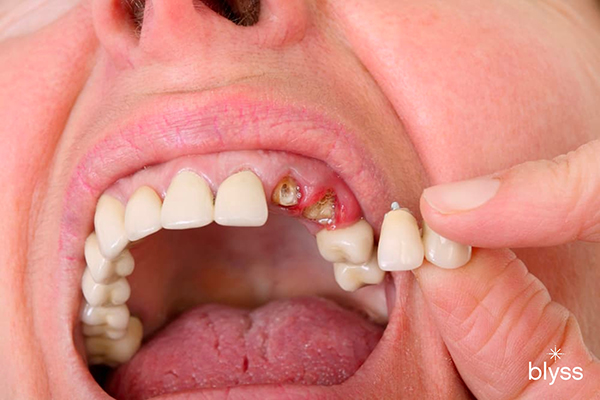
Damaged dental bridges can lead to serious issues, including pain and difficulty eating.
They can become loose or damaged due to impact, injury, or bruxism (teeth grinding).
Decay can also get under the bridge and damage the surrounding teeth. Changes in the alignment of your teeth can also affect how the bridge fits in your mouth over time.
To avoid bridge failure, it’s important to practice good oral hygiene.
Care Tips for Your Dental Bridge
Here are some care tips to make sure your dental bridge lasts as long as possible:
- Brush twice a day using a soft-bristled toothbrush and fluoridated toothpaste. You can also use an interdental brush to thoroughly clean between the bridge and adjacent teeth
- Don’t use an abrasive toothpaste that can scratch your bridge’s surface.
- Rinse your mouth with a mouthwash that fights bacteria, is alcohol-free, and is gentle on your teeth and gums.
- Floss regularly. Use a special floss, such as a floss threader, super floss, or water flosser, to thoroughly clean your pontics.
- Avoid sticky, hard, or crunchy foods such as nuts, gum, and hard candy.
- Avoid smoking and drinking alcohol in excess.
- Avoid using your teeth and bridgework as tools to open bottles, tear bags, and/ or other activities to avoid damage to your bridge.
- Wear a mouthguard at night if you have a habit of grinding your teeth.
- See your dentist regularly for cleanings and check-ups. I recommend it every six months.
Reason 6: Lower Upfront Costs
Dental bridges may be right for you if you’re on a tighter budget.
Typically, a dental bridge can cost about $1,000 to $2,500 per tooth. For example, a three-unit bridge is typically used to replace one tooth and may cost between $3,000 and $7,500.
While dental bridges may not be the cheapest option, they do provide a relatively lower upfront cost compared to other tooth replacement procedures, such as dental implants.
The upfront cost is generally lower because there’s no need for surgery or extensive preparation.
This makes it a great choice for those who don’t have the budget to invest in adental implant right away.
In addition, many health insurance plans cover part or all of the cost of bridges as they are considered necessary restorative treatments.
Most dental insurance policies will pay up to 50% of the final cost of a bridge, with an annual cap of $1,000 to $2,000. This means you could enjoy additional savings beyond what you would pay out-of-pocket.
Depending on their guidelines and policy limits, you may also qualify for assistance or coverage from your insurer if your bridge needs to be replaced down the road.
Talk to your insurance provider about how much they will cover before you make a final decision. This way, you will know how much you will have to spend out of pocket.
Related Post: Dental Implant Cost Insider Tips 2023 – How to Save Up to $20,000 On Your Dental Implant Procedure
Conclusion
Getting a dental bridge is an excellent way to restore your smile and improve your oral health and function.
The upfront cost may seem intimidating, but in the long run, it can save you from costly dental treatments due to more serious dental conditions. Plus, the treatment process is fast with minimal discomfort for most patients.
By taking care of your mouth and investing in a dental bridge, you’ll be able to enjoy a healthier, brighter smile for years to come.
Now that you know all the amazing reasons to get a dental bridge, what’s stopping you?
Don’t let your gaps hold you back from achieving the smile of your dreams.
Contact Blyss Dental today to book a free consultation.
Sources Cited From
- Dental bridge procedure. (n.d.). Healthdirect. https://www.healthdirect.gov.au/
dental-bridge-procedure - ADA Marketplace – American Dental Association. (n.d.-d). https://marketplace.ada.org/
blog/ dental-business/ tooth-implant-vs-bridge-what-top-dentists-are-recommending/ - Shetty S, Pitti V, Satish Babu CL, Surendra Kumar GP, Deepthi BC. Bruxism: a literature review. J Indian Prosthodont Soc. 2010 Sep;10(3):141-8. doi: 10.1007/s13191-011-0041-5. Epub 2011 Jan 22. PMID: 21886404; PMCID: PMC3081266.
